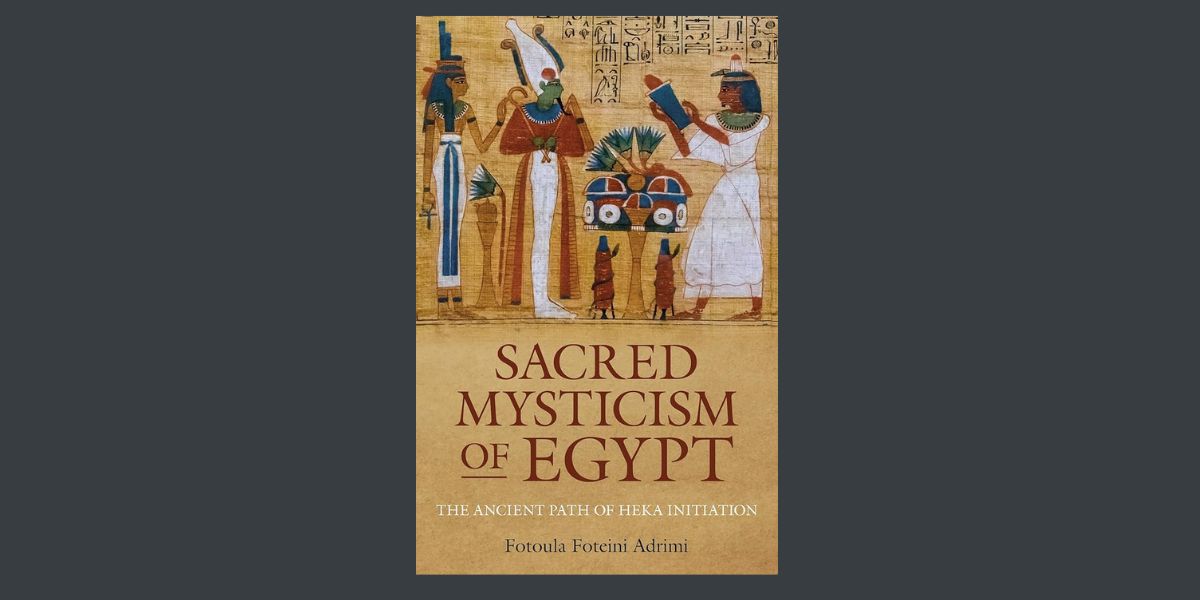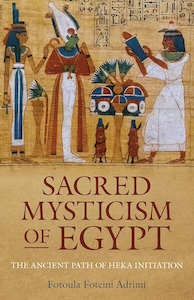
Sacred Mysticism of Egypt: The Ancient Path of Heka Initiation, by Fotoula Foteini Adrimi
O-Books, 978-1803417127, 296 pages, August 2025
“What happens when we consciously enter the vortex of etheric energy placed deliberately by the ancients? We might find that we are never the same. This book takes us on a journey through time and space, through dimensions and different realities, through self-acceptance and self-love, to lead us back into our infinite spirit, where the source of magic exists.”1
The quote above summarizes the intention of Sacred Mysticism of Egypt: The Ancient Path of Heka Initiation by Fotoula Foteini Adrimi. This book stirs within the reader a longing for return to what is inherently known in all of our being–that we are more than our corporeal form defined by self-imposed limitations and continually seeking its true nature as a being of light and citizen of the cosmos. This book calls the reader back to that true nature and provides the tools and understanding that stimulate a deeper memory that we have done this work before.
“Eons ago, a great civilization existed on Earth, in which human beings were aware of their spiritual nature. This civilization exists as soul memory and initiates deep longing towards harmonious spiritual living in a supportive community. The foundations of this extraordinary civilization were built on the spirituality of the Living Light, which provided the fundamentals for the Golden Times of ancient Egypt, described with the term Zep Tepi, “The Initial Time”2
This book is organized into twenty-one chapters and contained within three sections. A page of references and an always helpful glossary conclude the book. The introduction provides insight into the way in which the book is organized and the “why” behind this choice:
“The ancient Egyptians loved the number three..the most famous of these trinities is Osiris as the Father, Isis as the Mother and Horus as the Child….. Ausir (Osiris) is the first king, The heart is the foundation of the Living Light teachings….In the first part of the book I talk about Creation and Un-Creation , the journey of incarnation into a physical self and ascension into the infinite spirit… In the second part, we meet the Teacher of the Living Light, the ancient Egyptian Goddess Isis or Iset… Finally, Horan (Horus) is the spiritual warrior, who meets and overcomes the forces of chaos that keep him stuck. In Part 3, we encounter Horan as the falcon who has mastered its flight in the physical and spiritual realms.”3
“Part 1: The Golden Times Foundation Teachings” takes the reader on a journey of the Egyptian cosmology and consciousness of their spiritual workings. The palpability of energy and self-awareness flows through the writing, each chapter embedded with the author’s channeled information, the Egyptian subtle parts/bodies of self and opportunities to explore through personal engagement the teachings. We learn that an important part of Egyptian spirituality was in cultivating the Sahu (body of spiritual light, we all are in our true form), embodying that Living Light and thus, becoming one with all of the cosmos and living in harmony. This section, in particular, lays a suitable foundation for the teachings moving forward through the text and does a nice job of coalescing the intention that Ancient Egypt was seeded by the wisdom of Atlantean adepts and the further connection back to the mysteries of the star system of Sirius.
“Part 2: Initiation as a Channel of Heka” offers three chapters discussing three specific initiations: “Chapter 12: The Seven Gates of Awareness”, “Chapter 13: The Light of Atum”, and “Chapter 14: The Wisdom of Thoth”. In this section, the reader is introduced to the Egyptian concept of magic–HEKA.
“”the Living Light” energy that I and my guides refer to was known as HEKA, translated as “The Divine Invisible Power that rules all”. Another translation is “The mystical Divine power that creates the manifested world.””4
The chapters contained within this section provide the reader with examples of how the principles of awakening the Sahu (Living Light) are activated through initiatory practices. The rituals are gifted from the author and enable the reader to use them as a means of self-initiation on their path. The author’s own experiences are shared, laying the seeds for curiosity and deeper exploration for the reader.
“Part 3: Mystical Esoteric Practices of Ancient Egyptian Spirituality” completes the journey of awakening the Living Light. The ethics of the work are called forth in the teachings of Ma’at (both as Goddess and principle of ORDER) and the importance of the time within the Duat (the Egyptian underworld) needed to emerge as the Living Light are some of the highlights.
“We embark on a journey of spiritual resurrection and rebirth. We follow Iset inside the Great Pyramid and meet our Divine spirit. We Astro-travel to the world of the dead and walk a journey of self-renewal. This spiritual work parallels what happens when we die, enter the spirit realms, and reincarnate. Like Ausir (Osiris), we reincarnate as Horan (Horus), the one who becomes aware of being the spirit in the body.”5
This section is filled with deep wisdom as well as rituals and spiritual practices that enhance and have built one upon the other in the reading of Sacred Mysticism of Egypt.
Would I Recommend?
If you are drawn to the mythos and practices of Ancient Egypt and are curious about the spiritual practices of this unparalleled civilization, Sacred Mysticism of Egypt: The Ancient Path of Heka Initiation is definitely a read you will not be disappointed in. Adrimi has taken very complex practices and ideologies and managed to write in a form that is both coherent and usable, creating imagery and energy flowing from page to page that is nothing less than divinely inspired.
About the Author: Fotoula Foteini Adrimi
Fotoula Foteini Adrimi, BA(Hons), MSc, is the director of the ISIS School of Holistic Health, an international school of healing arts, spiritual development, and inner transformation through vibrational energy work, enlightened teachings, shamanism, and meditation. She is part of the global network of Shamanic Teachers under Sandra Ingerman. Fotoula lives and works in Glasgow, Scotland, has taught in Germany and the Netherlands, and has led spiritual pilgrimages to Egypt. Her first book, The Golden Book of Wisdom: Ancient Spirituality and Shamanism for Modern Times, is an Amazon UK bestseller. You can learn more on her website.
Robin Fennelly is an Elder within the Assembly of the Sacred Wheel Tradition [www.sacredwheel.org]. She is a dancer, teacher, astrologer, author, ritualist and seeker of all things of a spiritual nature. Her writings and classes incorporate a deep understanding of Eastern practice and Western Hermetics and bring a unique perspective towards integration and synthesis of the Divine and Mundane natures of our being. She is a mother of five and lives in Eastern PA with her husband of 45+ years.
